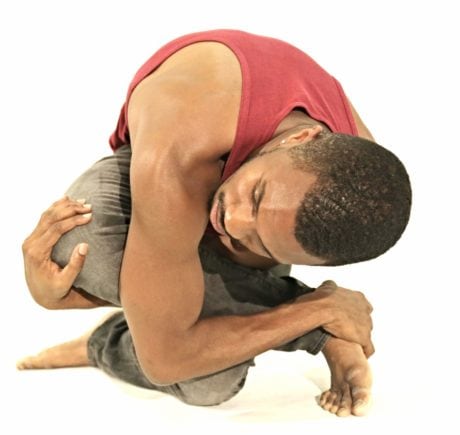Back in the ’60s, Bob Dylan wrote “The Times They Are a-Changing,” an ode to protest, social change and the country’s mood moment. Dance Place’s New Releases Choreographers Showcase vamped Dylan’s music and our current state of affairs in a performance program filled with dark shadows, pent-up emotions and the push-back of frustration that comes from living in uncertain times.
An annual event that is adjudicated and curated to present the best new works by emerging and established choreographers, the 2018 New Releases Choreographers Showcase presented five contemporary pieces that stir the soul to the depths of unrest and inner turmoil.

In This, choreographed and performed by Jamal Abrams, a shadowy male figure in the dim-lit distance immediately sparks a sense of suspicion. When that shadow turns out to be a young black man, the figure becomes a political statement and the dancer an unspoken source of fear and paranoia.
Jamal Abrams mimics the handwriting on the wall as if to write his own tragic epitaph in hurried hand movements that segue into snakelike, jerky gyrations and soaring leaps. He shuns the blinding spotlight that is following him to avoid its menacing glare. Like the proverbial Invisible Man, he gropes the black-out darkness that suddenly fails to recognize his presence. And he escapes the brutality of the light as he rolls to the floor then springs forward in a run to safety. This is an expressive commentary on the black man in America today and the shadows that stalk him. Lighting Designer Annie Choudhury’s spotlights and eerie shadows were vital to creating the essence of this piece.
Ritual is performed by a quintet of black divas, Ronya-Lee Anderson, Josie Hocver, Kira Jean Allen Burns, Stacey Smith and Angela Jones, choreographed by Ronya-Lee Anderson. It explores female body image, body-shaming and the constraints on a woman to be physically appealing.
The ladies begin with a nightly ritual of washing their faces; then, standing before imaginary mirrors, they preen while exploring the contours of their figures as they insecurely check themselves as if to ask, “Am I okay?” In carefree abandon, they playfully prance and shake their booties in gleefully funky movements– just plain showin’ off. But humorlessly never cracking a smile.
Finding themselves trapped inside cages projected on the floor, they defiantly move outside their constricted existence only to return again. Retrieving black boxes from a madam-like figure who is overseeing the whole affair, the ladies find treasure troves of sexy stiletto heels, fancy dresses and colorful head-wraps they are resigned to adorn themselves in. The divas exit lockstep in seeming acceptance of the rituals women go through to play the stressful game of being beautiful. Ritual is girls-night-out with a macabre twist.
Power plays are in full play in Boundless Trajectory. In a solo performance of his own choreography, Gabriel Mata enters an imaginary studio and begins to rehearse a piece that he has obviously worked hard to perfect. Mata is a powerful presence of regal grandeur, grace, determination, and strength. His movements are glorious: light-footed leaps like a flying eagle, daring backbends and deep pivots that touch the ground then soar to greater heights with total ease and control.
Suddenly, out of the blue comes this annoying voice (Chris Wills), perhaps a rich producer or a crazy stage manager (who obviously knows little about dance) from the back of the hall. He criticizes Mata’s every move and asks him to change the choreography. Mata complies and does his best to get it right.
This scenario repeats several times before Mata finally takes a hike to get the hell outta there! The work is a choreographic delight in identifying universal frustrations, through movement, that pretty much everyone can identify with. But Gabriel Mata, a wonderful dancer, performs Boundless Trajectory with such élan that it is a guilty pleasure to watch him suffer!
In a purported spinoff from the Greek tragedy Icarus and Daedalus, choreographers Sylvana Christopher and Maggie Lockhart perform their own creation in Then She Fell. The piece starts out with the interplay of two copacetic performers who joyously use grand, sweeping arm movements and collaboratively supportive gestures balancing one another. Harmony quickly devolves to feline pettiness, however, through catty slamming motions and prickly slaps of disappointment and conflict.
Of all the pieces in the New Releases Choreographers Showcase, this one seemed most out of sync with its Choreographer’s Note, which referred to being inspired by Greek mythological “themes of greed and addiction.” Then She Fell felt more like a breezy catfight than a lofty Hellenic tragedy.

The final piece of the evening was Loop: Whatever Happened to Halle Berry, a 2017 New Releases Commission Recipient. Choreographed by Tarik O’Meally that he performed in collaboration with Jamal Abrams, Jaya Bond and Tyesha Nance, according to his Choreographer’s Note, this work expresses the notion that progress has nothing to do with our perception of it.
The performers made a repetitive statement with their arms raised stick-straight above their heads as if depicting a Ferguson-like hands-up-don’t-shoot gesture. Body trembling and cradled heads, swooping drops to the ground and body roll movements felt as if the performers were expressing an inability to cope with the stress of social injustice.
And through their stark incapacity to keep pace with the rapid, agitating rhythms of Julius Eastman’s “Evil Nigger” soundtrack, the performers symbolically succumb to the pressures of just being oneself.
I recently had the pleasure of seeing Tarik O’Meally in MK Abadoo and Vaughn Midder’s Wake Up! at Dance Place, a performance dance work that included dialogue along with everything from hip hop, vogueing and twerking to the Lindy Hop. O’Meally displayed his versatility in Loop: Whatever Happened to Halle Berry, a traditional contemporary piece that also had a message.
The New Releases Choreographers Showcase was as entertaining as it was artistically rich in symbolism and exceptional dancing.
Running Time: One hour, with a 15-minute intermission.
New Releases Choreographers Showcase played May 26, 2018, at Dance Place – 3225 8th Street, NE, in Washington, DC. For tickets to other Dance Place events, call (202) 269-1600, or purchase them online.




